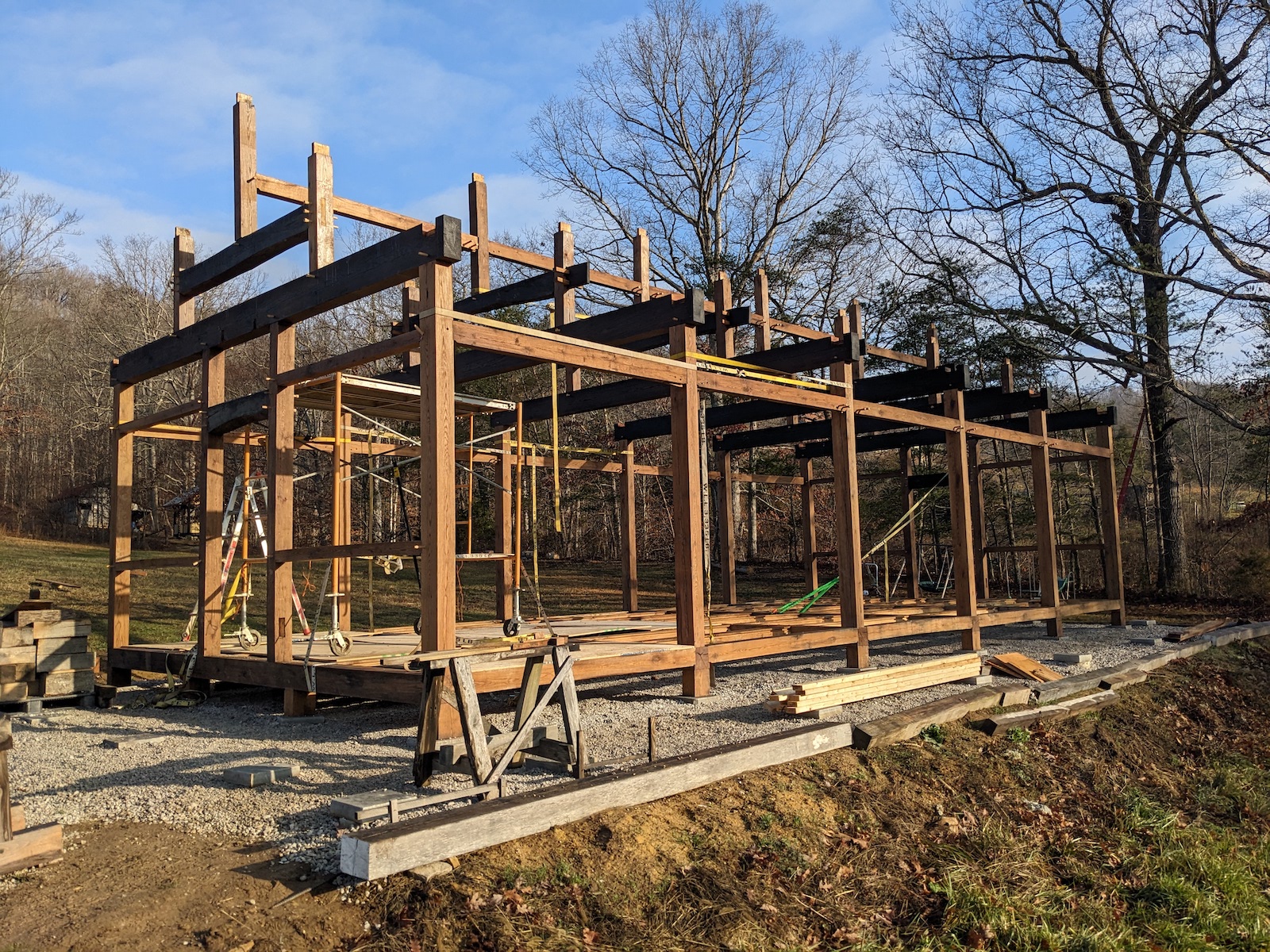Happy New Year, dear readers.
It’s been an eventful year. Recently, we achieved a substantial amount of “visual progress” on our ongoing timber frame pavilion project — we raised the frame, finally moving pieces out of the big tent and into the field for assembly and lifting them up into their final resting place.
And it feels really, really good to be at this stage in the game.
Slow & Steady
There’s been slow and steady progress for months, but sometimes it’s been slower than I’d like. (Impatience is a struggle.) Sometimes, it feels like things move backwards before they go forwards again. (Mistakes can be hard.) And sometimes, the thought of these timbers actually coming together into a physical space has felt like a distant dream. (Tunnel vision can be stifling.)
Sometimes that’s what happens during a big project.
Floor Assembly & Bent Raising
In November, we assembled the floor frame. Because of the intense bow in some of the oak 8×8 girders, a lot of strapping was necessary. Ultimately, it came together fairly well. It was nice to finally see wood on top of the finished foundation. The actual scale of the building started to dawn on me.
Later in December, we assembled a crew to help with raising the bents. I decided to use a winch rather than rent equipment for lifting. The bents themselves weren’t particularly heavy, just very wide and unwieldy. Human power would not suffice. The winch, powered by a pickup truck and directed through a pulley high up on a tree (and later, on the frame itself) worked more or less seamlessly.
There was plenty of shuffling timbers, bracing things off, installing connectors — all the extra hands were essential for turning the raising into a single day event, rather than dealing with the process over a longer duration. Thankfully, there were few hiccups and we finished just as the light was fading. The next day, I woke up and it struck me just how much of a transformative effect this building will have on the landscape. Hopefully positive, of course.
Lifting the Big Beams
We quickly turned around and began preparations for lifting the plates / purlins the next weekend. This was the part of the raising that I’d been fearing and fretting over the most. The plates are 3 intimidating lengths of 6×10 white oak timbers, equaling a total length of 52’ once they’re joined. And there are 7 lengths, or 21 total pieces. These pieces have been a source of at least mild, if not significant heartache for months. They’re big, heavy, the original sawing from the mill was hit or miss, etc. A few needed to be replaced at one point. Blah blah. Anyway, that’s just how it goes.
The plan was to rent a telehandler and raise them up from a comfortable position. At the last minute, I was forced to get a bigger telehandler (with longer reach, but much heavier overall). In every way, the bigger machine proved to be a blessing. It turned out that the surrounding site was too wet to drive on, so we had to lift everything from one graveled end of the building. We used every last available inch of the full reach of the machine. We pre-assembled two of the three beams and lifted those, and raised the final piece by itself and made the last scarf connection in place.
There would have been no feasible way to set the plates without the larger machine. I had never driven a telehandler before, so that presented me with some anxiety beforehand. Everything turned out to be just fine, though. The weather was good enough, too. (The following weekend is when the temperature dropped to -1 degree.)
It took two long days, with a slow start and much more confident finish. Things fit about as well as expected — some trimming here and there, and one or two mistakes that I had time to correct in-between lifts. All in all, not bad. I didn’t take a single picture — way too much going on to think about snapping pictures, unfortunately.
The work continues with rafters, and eventually roof decking. There’s plenty more to come. But this is a big hurdle to have cleared.










